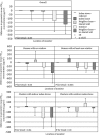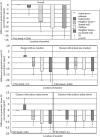Air pollution dispersion from biomass stoves to neighboring homes in Mirpur, Dhaka, Bangladesh
- PMID: 31014315
- PMCID: PMC6480710
- DOI: 10.1186/s12889-019-6751-z
Air pollution dispersion from biomass stoves to neighboring homes in Mirpur, Dhaka, Bangladesh
Abstract
Background: Indoor air pollution, including fine particulate matter (PM2.5) and carbon monoxide (CO), is a major risk factor for pneumonia and other respiratory diseases. Biomass-burning cookstoves are major contributors to PM2.5 and CO concentrations. However, high concentrations of PM2.5 (> 1000 μg/m3) have been observed in homes in Dhaka, Bangladesh that do not burn biomass. We described dispersion of PM2.5 and CO from biomass burning into nearby homes in a low-income urban area of Dhaka, Bangladesh.
Methods: We recruited 10 clusters of homes, each with one biomass-burning (index) home, and 3-4 neighboring homes that used cleaner fuels with no other major sources of PM2.5 or CO. We administered a questionnaire and recorded physical features of all homes. Over 24 h, we recorded PM2.5 and CO concentrations inside each home, near each stove, and outside one neighbor home per cluster. During 8 of these 24 h, we conducted observations for pollutant-generating activities such as cooking. For each monitor, we calculated geometric mean PM2.5 concentrations at 5-6 am (baseline), during biomass burning times, during non-cooking times, and over 24 h. We used linear regressions to describe associations between monitor location and PM2.5 and CO concentrations.
Results: We recruited a total of 44 homes across the 10 clusters. Geometric mean PM2.5 and CO concentrations for all monitors were lowest at baseline and highest during biomass burning. During biomass burning, linear regression showed a decreasing trend of geometric mean PM2.5 and CO concentrations from the biomass stove (326.3 μg/m3, 12.3 ppm), to index home (322.7 μg/m3, 11.2 ppm), neighbor homes sharing a wall with the index home (278.4 μg/m3, 3.6 ppm), outdoors (154.2 μg/m3, 0.7 ppm), then neighbor homes that do not share a wall with the index home (83.1 μg/m3,0.2 ppm) (p = 0.03 for PM2.5, p = 0.006 for CO).
Conclusion: Biomass burning in one home can be a source of indoor air pollution for several homes. The impact of biomass burning on PM2.5 or CO is greatest in homes that share a wall with the biomass-burning home. Eliminating biomass burning in one home may improve air quality for several households in a community.
Keywords: Air pollution; Bangladesh; Biomass stove; Carbon monoxide; Fine particulate matter.
Conflict of interest statement
Ethics approval and consent to participate
All participants provided written informed consent. The study protocol was approved by the institutional review boards at icddr,b and the University at Buffalo.
Consent for publication
Not applicable.
Competing interests
The authors declare that they have no competing interests.
Publisher’s Note
Springer Nature remains neutral with regard to jurisdictional claims in published maps and institutional affiliations.
Figures





Similar articles
-
Patterns of domestic exposure to carbon monoxide and particulate matter in households using biomass fuel in Janakpur, Nepal.Environ Pollut. 2017 Jan;220(Pt A):38-45. doi: 10.1016/j.envpol.2016.08.074. Epub 2016 Oct 1. Environ Pollut. 2017. PMID: 27707597 Free PMC article.
-
A cross-sectional study of determinants of indoor environmental exposures in households with and without chronic exposure to biomass fuel smoke.Environ Health. 2014 Mar 24;13(1):21. doi: 10.1186/1476-069X-13-21. Environ Health. 2014. PMID: 24655424 Free PMC article.
-
Indoor air pollution concentrations and cardiometabolic health across four diverse settings in Peru: a cross-sectional study.Environ Health. 2020 Jun 3;19(1):59. doi: 10.1186/s12940-020-00612-y. Environ Health. 2020. PMID: 32493322 Free PMC article.
-
Characterising Carbon Monoxide Household Exposure and Health Impacts in High- and Middle-Income Countries-A Rapid Literature Review, 2010-2024.Int J Environ Res Public Health. 2025 Jan 15;22(1):110. doi: 10.3390/ijerph22010110. Int J Environ Res Public Health. 2025. PMID: 39857563 Free PMC article. Review.
-
Cardiovascular effects of household air pollution on cardiovascular diseases incidence.Clin Investig Arterioscler. 2025 Feb 25:500770. doi: 10.1016/j.arteri.2025.500770. Online ahead of print. Clin Investig Arterioscler. 2025. PMID: 40011114 Review. English, Spanish.
Cited by
-
Household and personal air pollution exposure measurements from 120 communities in eight countries: results from the PURE-AIR study.Lancet Planet Health. 2020 Oct;4(10):e451-e462. doi: 10.1016/S2542-5196(20)30197-2. Lancet Planet Health. 2020. PMID: 33038319 Free PMC article.
-
The impacts of cooking and indoor air quality assessment in the southwestern region of Bangladesh.Heliyon. 2023 Jan 7;9(1):e12852. doi: 10.1016/j.heliyon.2023.e12852. eCollection 2023 Jan. Heliyon. 2023. PMID: 36711262 Free PMC article.
-
Exposure of children to smoke in clay figures craft in Caruaru, state of Pernambuco, Brazil.Rev Bras Med Trab. 2023 Apr 18;21(1):e2023844. doi: 10.47626/1679-4435-2023-844. eCollection 2023 Jan-Mar. Rev Bras Med Trab. 2023. PMID: 37197337 Free PMC article.
-
Systems Science Approaches for Global Environmental Health Research: Enhancing Intervention Design and Implementation for Household Air Pollution (HAP) and Water, Sanitation, and Hygiene (WASH) Programs.Environ Health Perspect. 2020 Oct;128(10):105001. doi: 10.1289/EHP7010. Epub 2020 Oct 9. Environ Health Perspect. 2020. PMID: 33035121 Free PMC article.
-
A Cross-Sectional Analysis of the Association between Domestic Cooking Energy Source Type and Respiratory Infections among Children Aged under Five Years: Evidence from Demographic and Household Surveys in 37 Low-Middle Income Countries.Int J Environ Res Public Health. 2021 Aug 12;18(16):8516. doi: 10.3390/ijerph18168516. Int J Environ Res Public Health. 2021. PMID: 34444264 Free PMC article.
References
-
- World Health Organization . Burden of disease from Household Air Pollution for 2012: Summary of results. Geneva: World Health Organization; 2014.
-
- Gurley ES, Homaira N, Salje H, Ram PK, Haque R, Petri W, Bresee J, Moss WJ, Breysse P, Luby SP, Azziz-Baumgartner E. Indoor exposure to particulate matter and the incidence of acute lower respiratory infections among children: a birth cohort study in urban Bangladesh. Indoor Air. 2013;23:379–386. doi: 10.1111/ina.12038. - DOI - PMC - PubMed
-
- Salje H, Gurley ES, Homaira N, Ram PK, Haque R, Petri W, Moss WJ, Luby SP, Breysse P, Azziz-Baumgartner E. Impact of neighborhood biomass cooking patterns on episodic high indoor particulate matter concentrations in clean fuel homes in Dhaka, Bangladesh. Indoor Air. 2014;24(2):213–20. - PMC - PubMed
-
- Gurley ES, Salje H, Homaira N, Ram PK, Haque R, Petri WA, Jr, Bresee J, Moss WJ, Luby SP, Beysse P, Azziz-Baumgartner E. Indoor exposure to particulate matter and age at first acute lower respiratory infection in a low-income Urban Community in Bangladesh. Am J Epidemiol. 2014;179(8):967–973. doi: 10.1093/aje/kwu002. - DOI - PMC - PubMed
MeSH terms
Substances
Grants and funding
LinkOut - more resources
Full Text Sources
Medical

